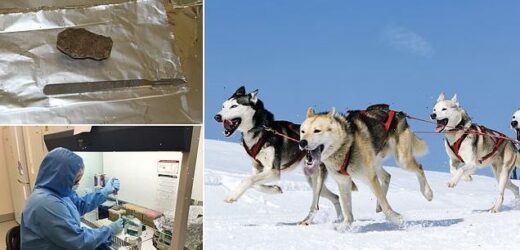17th century sled dogs were CANNIBALS: Analysis of frozen faeces samples reveals pups ate one another to fuel their strenuous journeys through the Arctic
- Researchers have analysed frozen canine faeces samples from Alaska
- They discovered proteins from both salmon and from other dogs
- This suggests dogs had to turn to cannibalism to fuel their journeys
Sled dogs have been used in the Arctic for at least 2,000 years, tasked with pulling heavy loads during long journeys through the tundra.
Now, a new analysis reveals that sled dogs in the 17th century turned to cannibalism in order to fuel themselves on their journeys through the Arctic.
Researchers from the University of York have analysed frozen faeces, extracting proteins from the samples to reveal more about the diets of Arctic sled dogs.
The findings suggest that while the dogs’ diets contained high amounts of salmon, some pooches were forced to turn to cannibalism to remain well-fuelled.
Sled dogs have been used in the Arctic for at least 2,000 years, tasked with pulling heavy loads during mammoth journeys through the tundra (stock image)
In the study, the team studies frozen canine faeces collected from the Nunalleq archaeological site, near Quinhagak, Alaska.
This site was known to be occupied between 1300 CE and 1750 CE.
The proteins revealed that the dogs consumed muscle, bone and intestines from a range of salmon species, including chum salmon, often called ‘dog salmon.’
However, a bone fragment in one of the samples was identified as being from a canid.
In the study, the team studies frozen canine faeces collected from the Nunalleq archaeological site, near Quinhagak, Alaska
This suggests that the dogs also ate other dogs – a finding that is supported by previous observations of gnaw marks on discarded bones.
Anne Kathrine Wilborg Runge, who led the study, said: ‘The lives of dogs and their interactions with humans have only recently become a subject of interest to archaeologists.
‘This study of their dietary habits reveals more about their relationship with humans.
‘In the Arctic, dogs rely exclusively on humans for food during the winter but deciphering the details of provisioning strategies has been challenging.
‘In places like the Arctic the permafrost has preserved palaeofaeces. Now they can be used as a unique source of information by which we can learn more about the past.’
To recover proteins from the samples, the researchers used palaeoproteomics – a technique based on tandem mass spectrometry that allows experts to see which tissues the proteins originated from.
To recover proteins from the samples, the researchers used palaeoproteomics – a technique based on tandem mass spectrometry that allows experts to see which tissues the proteins originated from
A follow-up analysis was then performed on bone fragments from within the faeces.
Ms Wiborg Runge added: ‘Arctic dogs rely exclusively on humans for food during the long winters, but may have been fed differently or less frequently in summer, or been let loose to fend for themselves.
‘Working sled dogs are a particularly expensive resource, requiring up to 3.2 kg of fish or meat every day and provisioning of dogs would therefore have played a significant role in the food procurement strategies of past arctic cultures.’
Dog breeds that make the best sled dogs
The Samoyed, Alaskan Malamute (pictured), Siberian Husky, Chinook are some of the most well-known of the sled-dog breeds
The Samoyed, Alaskan Malamute, Siberian Husky, Chinook are some of the most well-known of the sled-dog breeds, and with good reason.
Sled dogs probably evolved in Mongolia between 35,000 and 30,000 years ago.
Scientists think that humans migrated north of the Arctic Circle with their dogs about 25,000 years ago, and began using them to pull sleds roughly 3,000 years ago.
There are historical references to dogs used by Native American cultures dating back to before the first Europeans made land.
There were two main types of sled dogs: one kept by coastal cultures and the other by people living in the interior.
In the mid-1800s Russian traders following the Yukon River inland and acquired sled dogs from the villages along its shores.
Source: American Kennel Club
Source: Read Full Article






